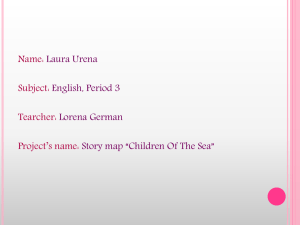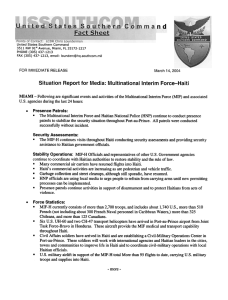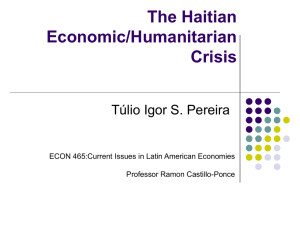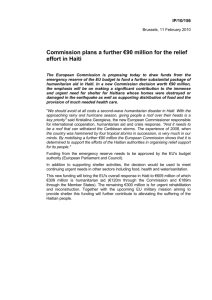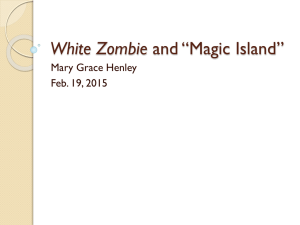CALIFORNIA STATE UNIVERSITY, NORTHRIDGE HAITI IS A NATION OF ARTISTS
advertisement
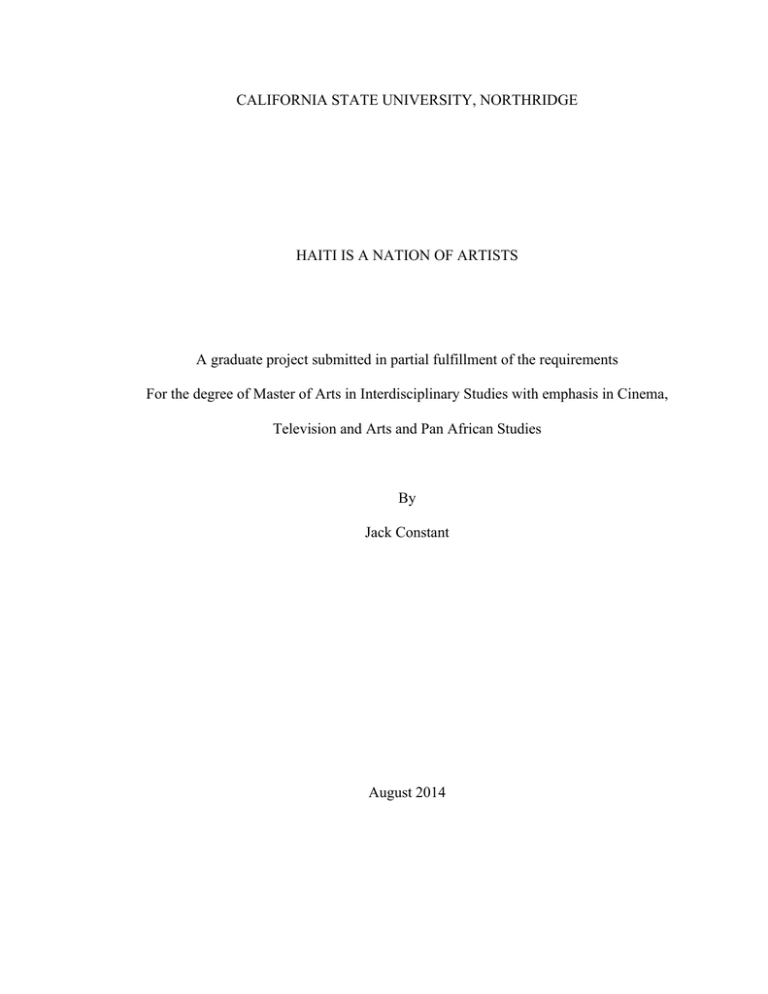
CALIFORNIA STATE UNIVERSITY, NORTHRIDGE HAITI IS A NATION OF ARTISTS A graduate project submitted in partial fulfillment of the requirements For the degree of Master of Arts in Interdisciplinary Studies with emphasis in Cinema, Television and Arts and Pan African Studies By Jack Constant August 2014 The graduate project of Jack Constant is approved. ____________________________________ Professor Alexis Krasilovsky ________________________ Date ____________________________________ Dr. Anthony Ratcliff ________________________ Date ____________________________________ Professor Michael Hoggan, Chair ________________________ Date California State University, Northridge ii Table of Contents SIGNATURE PAGE ii ABSTRACT iv HAITI IS A NATION OF ARTISTS iv iii ABSTRACT HAITI IS A NATION OF ARTISTS By Jack Constant Master of Arts in Interdisciplinary Studies with emphasis in Cinema, Television, Arts and Pan African Studies In January 2010, Port Au Prince, Haiti was stuck by an 8.0 magnitude earthquake that killed over 200,000 people. This tragic event devastated Haiti but also highlighted the resilience and strength of its people. Although much was lost for many in the earthquake, artists utilized available resources to create art that was uplifting. Haitian art is perceived to be naïve and primitive in the art world. The basis of my short documentary project is to challenge such negative ideals and showcase the vast artistic talents that Haiti has to offer. Over the past four years, I conducted video interviews of Haitian artists, gallery owners, and academics both in Haiti and across the United States and discovered the untold history and diversity of Haitian art. Through this short video art documentary I will show the humanity of the Haitian culture and how the Haitian Diaspora is using art to uplift their country and themselves. The documentary Haiti Is A Nation of Artists portrays the humanity and rich culture of Haiti. I shot the documentary from a subjective perspective interviewing gallery owners in Petion-ville, and Haitian artists in the diaspora. The documentary displays how art can transform chaos after the earthquake on January 12, 2010 that killed 200,000 people. iv I am a Haitian-American filmmaker raised in California and I will portray Haiti from an authentic point of view. The media portrays Haiti from an ethnographic perspective that shows the negative image of Haiti being an impoverished nation. My intention as a Haitian-American filmmaker is to display the resilience of Haitian artists coping with the earthquake by creating art through the lens of re-imagining Haiti as a prosperous nation rich in culture. The theme of the documentary is how art allows the artists a refuge to escape the harsh realities of their society. Contemporary Haitian art is about an historical awareness of black culture, and African culture transformation in the Americas that has inspired generations of artist. Haitians create from an Afrocentric perspective in which emphasis is placed on oral transmission of cultural, historical, and contemporary information. In Haiti today, the atmosphere is filled with art, from the Haitian taxi called a tap-tap where you see paintings drawn on the side of their cars to display favorite artists like Jay Z or a painting of Jesus Christ. I interviewed six artists describing their art and their contribution to an emerging art scene in Haiti. The first artist I interviewed was Jean Claude, a brilliant Haitian painter in the city of Port au Prince in the Downtown area at the Art Super Marché (Art Supermarket). Jean Claude is a sixty-year-old artist with a slender build and dark complexion. He described beautiful narratives about how art comes from his heart, and he loves his paintings as if there were his mother and sister. I was compelled to purchase two of his beautiful colored paintings. The first painting I purchased was an oil painting that had one-hundred peasant women at the marketplace wearing beautiful yellow dresses v with colorful head wraps. The women are selling mangoes, rice, and avocados. The second painting demonstrated Jean Claude ability to utilize bold colors in great detail of six fisherman’s boats. The sky is illustrated with untraditional colors of red and yellow giving the painting a dreamlike image of Haiti. I also interviewed three young painters from Petion-ville, a middle class suburb in the Haiti. Petion-ville suburb that is filled with Haitian art. There is an entire block dedicated to paintings on both sides of a four-foot cement wall that has a fence over it. This Haitian art atmosphere is rich in culture and different styles of painting; such a beautiful sight. The first artist I interviewed in Petion-ville, Famille Louis, was trained at an art school called Ecole Salessiens in Port au Prince, Haiti. Famille Louis is a young man of 22 years old with an urban look, with a New York hat and had paint all over his jeans and shirt. His painting called Reve D’Haiti (Dream of Haiti). The painting shows a parrot on a branch with yellow and blue in a beautiful tropical scene. The painting displays his imagination of Haiti being a prosperous nation. Next, Louis Saurel was self-trained in painting by observing other painters. Louis is 25 years old with a noticeably relaxed disposition. His demonstrated painting is called Pentre You Ti Limye Nan Fenus (The Little Light In The Darkness). The painting shows three wooden houses on a cliff. Underneath the cliff is a calm river moving gracefully down the stream. This artist is charming because of his personality, which is evidence in the brilliant detail in his work. My third interview was Jacques Jr. whose painting was of a beautiful woman with round features that symbolizes Haiti as a woman. Jacques Jr. is a thirty two year old artist who is very serious about making a living as an artist through his vi paintings. He was inspired to paint the picture because of the birth of his daughter. Another artist I interviewed was Frantz Jacques Aliss (Gurido); a young contemporary creative genius that recycles used car parts from America and transforms it into art. He has his own sculpting studio in Grand Rue in the ghetto of Port Au Prince where he also teaches young artists in his neighborhood about making art with raw materials that are available in their environment. He mentors youth in his neighborhood in order to provide the youth in the ghetto a creative outlet to inspire them to make positive contribution to society. These students’ art projects have exhibited their contemporary sculptures of recycling American used cars and making them an artistic expression in Switzerland. Also Frantz Jacques has travelled to numerous countries overseas showcasing his art. He is a very charismatic and he believes that defends Haitian art has bypassed European art and Haitian art is not primitive. I interviewed a total of four gallery owners Carine Fabius (Gallery Lakaye), Georges Nader Jr. (Nader Museum), Gallerie Monnin (Gallery Monnin), Reynald Lally (BoubonLally Gallery). I interviewed Carine Fabius, who is art curator in West Hollywood, California and who has a gallery called Gallerie Lakaye (Gallery House). It was during my interview with her, I found the title to my feature documentary (Haiti Is A Nation of Artists). Her gallery is a place where I saw the beauty of Haitian art and culture through art. Carine Fabius is a tremendous cultural gem and art haven for the Haitian American community and Haitian art lovers in Los Angeles. vii I traveled to Haiti to interview Georges Nader Jr., where his Galerie D’Art Nader has the largest collection of Haitian Art (twenty thousand), but three thousand were destroyed during the earthquake. Some of the art is in a restoration process through the assistance of the Smithsonian in Washington D.C. Georges Nader established the gallery in 1966 and became a renowned institution for Haitian Art. His son Georges Nader Jr. established the first private Haitian art exhibit in the 1992. His Georges Nader Jr. went to the NYU art school, then took over his family business in the 1990’s and expanded it into a private gallery. I interviewed Pascale Monnin a female artist and her father Michael Monnin who run the business of the gallery. Gallerie Monnin a family from Switzerland that has been in existence since the 1947. This was an exciting time for Haiti because the art explosion in the 1950’s by Centre D’ Art in Port Au Prince. The Gallerie Monnin specializes in self-taught artist of Haiti. My last interview in Haiti is with gallery owner, Reynald Lally, a former oil bureaucrat who became an art dealer in 1992. Reynald Lally lived in London until he fell in love with Haitian art by seeing beautiful art in a book. He ventured to Haiti where he fell in love with its art. Boudon-Lally Gallerie is eceletic style of Haitian art with an emphasis on the contemporary art scene. His gallery was also destroyed during the earthquake but still displays his collection online and curator’s Haitian art exhibits. He has some provocative things to say about how the Haitian Diaspora could support Haitian artists to increase the value of the art form. Haitian art needs collectors to enhance Haitian art value in the art world. viii The main argument of this thesis is that art critics or art institutions should not classify Haiti’s diverse art community as primitive because Haitian art has been in existence since 1804, because Haitians fought for their independence and won in 1804. Typically the term primitive art”, intended to mean is artwork that is created by an artist without formal training; simple or naïve in style. I disagree and contend that it is Eurocentric to think Haitian art is primitive. Artists from Haiti have been making art for generations. Haitian artists have developed an authentic style of art and should be acknowledge for their great work, and craftsmanship. In the 1940’s, Dewitt Peters, an American art teacher from California, started the Centre d’ Art an Art School in Port Au Prince, Haiti, which created a new platform for Haitian artists to display their art form to the world. Haiti needs a new identity. Instead of being viewed as the western hemisphere’s poorest nation. My ambition as a filmmaker is to help Haiti be recognized as a nation that produces the highest quality and most black art in the world because of its rich history and the resourcefulness of its people. ix


